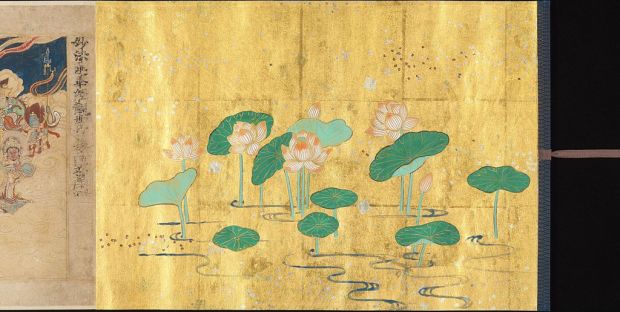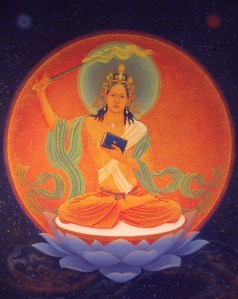
Image by Dh. Aloka
- Bowing to Manjughosha’s Mind, Speech and Body
To you whose wisdom
Purifies like a cloud-free sun
The veils of passions and of ignorance,
Yielding perfect clarity;
To you who sees all matters as they are,
And so holds the book
Of Prajnaparamita to your heart,
To your mind, Manjughosha, I bow.
To you whose kindness
Views each being as your only son,
Covered in avidya’s darkness,
Afflicted in the prison of time;
To you who utters the sixty-four-fold voice,
Resounding loud as thunder,
Rousing from passion’s sleep,
Shattering karma’s prison fetters,
Dispelling avidya’s darkness;
To you who grasps the sword of wisdom
To cut every shoot of duhkha,
To your speech, Manjughosha, I bow.
To you whose perfect body-of-virtues,
Chief among the Buddhas and Bodhisattvas,
Always pure, yet completing the Bodhisattva path,
Adorned with one hundred and twelve blazing ornaments,
Dispersing my mind’s darkness,
To your body, Manjughosha, I bow.
- Manjughosha mantra, and offerings
2. Praise of body
O Manjughosha, treasure of wisdom,
Please for one moment consider
These flowers of verses of praise
Quivering in the wind of faith,
O radiant mass of rays of saffron light,
Like a golden mountain
Embraced by the rays of the rising sun.
Your mountain body is tall and stable,
Your skin is pure and clear
Like soft dust of gold.
Your long, lustrous black hair
Is bound in a knot
And five gem-adorned crests,
Above a brow like the waxing moon.
Your eyes are long, and blue as utpala,
Your mouth is smiling and well-pleased.
From your fine ears
Dangle gem-adorned earrings,
And you wear many other ornaments.
Adorned with armlet and bracelet
Your right hand holds the sword
That cuts the root of the tree of materialism.
Your left hand holds to your heart
The supreme volume
Of exact and full teachings
Of the sole doorway to peace.
Your robe of silk shimmers
And is hemmed with tinkling bells.
You sit in vajra posture
On moon disc, and the saffron centre
Of a six-petalled lotus.
Like the thousand rayed sun
Plunging its seven horses
Into the golden ocean,
Your body everywhere shines.
When I behold your body
I weary of my long wandering.
May my erring mind
Come into the spirit of Enlightenment.
- Reading
- Praise of Speech
O Manjughosha, Lord of sweet speech
Your many voices fill all lands
In every different language
Like a crystal prisming all colours,
Satisfying all living beings.
The melody of your speech
Is like a sphere of music,
Outlasting all the Samsara,
Releasing from sickness, age, and death.
It is pleasant, gentle, heart-stirring,
Harmonious, stainlessly clear, and sweet.
It is not rough, very calm, painless,
And satisfies body, mind, and heart.
It is rational, relevant,
Free of all redundancy,
All-informing, totally illuminating, enlightening.
Its rhythm not too fast or slow,
Its tone sweet, penetrating everywhere.
Its phrases are complete and confident,
Pervaded with joy and insight.
Emerging victorious, it dispels the three times.
These are some of the qualities
present in each and every utterance
Of your Brahma voice.
Not too loud when near,
Not too faint when far,
As if it manifests from the sky
Like the thunder in the rain-cloud
Girt with its belt of red lightning.
Just by hearing your stream of speech,
The receptive accept it,
Condemning wrong discourse,
May I never be parted from hearing your speech!
- Manjughosha’s teaching
O Manjughosha, Lord of Dharma,
Certain of the true colour
Of all that can be known
May you grant superlative wisdom
As the supreme refuge.
Not one phenomenon
Is hidden from you,
Thus you never exceed just proportion
In the training of your pupils’ faculties.
You see how sharp or dull are their abilities,
In faith, memory, samadhi and so on,
And so yours is the highest skill
In teaching Dharma.
Since you know entirely
The spiral path
And the Transcendental path,
And the way that leads
To states of misery,
You are the best spiritual friend
Of living beings.
Please grant the supreme instruction
Of the Buddhas!
The elephant of my mind
Is hard to tame,
As it runs amok
In the jungle of unconsciousness.
It is drunk on the liquor of materialism,
Knowledge of right and wrong forgotten,
Wrecking the trees of virtue,
Dragged by the chains of existence’
Losing the female elephant of success.
I should bind it with the rope
Of conscience and mindfulness,
And guide it with the goad of true reasoning
Onto the good Aryan path,
Trodden by millions of supreme sages.
With tireless effort on that path,
By meditating again and again
Without giving up,
I shall reach the Vajra-like Samadhi,
And the mountain of extremisms
Shall be rendered merely a name.
- Reading: The Song of the four mindfulnesses. (A teaching said to have been received by Tsongkapa from Manjughosha.)
4. Praise of mind
O Manjughosha, lord of Wisdom
Just as the king of eagles
Soars in the heavens,
Your mind stays neither in existence
Nor in peace.
By praising your mind,
May I never part from the wisdom
And love of Manjughosha.
False appearances entirely conquered,
You dwell in the chief of all samadhis.
By your power over appearances,
And your clear knowledge of all experience,
You enter the ultimate realm.
Like a poison tree whose root is destroyed,
And the seeds of all habits eradicated,
how could you ever deviate, O refuge,
From the Dharmakaya?
Though you never leave the ultimate realm,
You know individually in every instant
The vivid appearance of many objects,
Like a rainbow, or reflections in a mirror.
Your direct vision, free of all veils,
Sees the Nirvana that ends defilements,
And its means, the eightfold path.
Thus you are the best of all refuges.
Long you practised the goal of compassion,
The sole path of all victors,
The entrance to the battle
Of the hero Bodhisattvas.
Loving one, you see the errors
Of forsaking others’ happiness.
You never allow suffering to continue,
And are never content
With the most alluring of pleasures.
By your long cultivation of Bodhicitta,
Seeing the equality of self and others,
Practising the exchange of self and others,
You hold all beings as yourself.
- Svabhavashuddha mantra –
5. Aspiration
Though seeking desperately,
I find no good refuge other than you.
Turning to you, my mind
Feels like a sunburnt elephant
Plunging in the lotus pool!
Having attained an infinite store
Of samadhis and doors of liberation,
May I manifest limitless bodies
To see the Jinas
In a million universes.
Then, having reached the limit of wide learning,
Satisfying limitless beings
With the Dharma,
May I before long attain
The supreme body
Of the chief of jinas, Manjughosha!
Obtaining supreme understanding,
May I cut off the doubts
Of all living beings.
Never transgressing your instructions,
Through devoted, one-pointed practice,
May I quickly gain mastery of speech.
With the vision that belies all extremism,
And the compassion that sees all
As my only child,
May I lead all beings
Onto the supreme vehicle.
Remembering all teachings,
Able to answer all questions,
May I spread out the feast
Of eloquent Dharma.
By the glory of the mind of Manjughosha,
Who, without calculating,
Fulfils the hopes of all,
May I become like you,
As beautiful as the autumn moon,
Whose sweetness fills the limitless sky.
- Concluding mantras
Ratnaprabha, compiled and re-rendered September 1994, at Guhyaloka retreat Centre, Spain.
The first part is a revised version of the traditiona Manjughosha Stuti. The rest is all adapted from Tsong Khapa’s ‘Cloud Ocean of Praises of Manjushri’, in Thurman, R., ed., Life & Teachings of Tsong Khapa (Library of Tibetan Works and Archives, Dharamasala, 1982), 188-197.




 As he lay on his deathbed between the twin Sal Trees, the Buddha’s parting words were: “Be your own light, be your own refuge, the Dharma is your light and refuge. Things naturally decay: win through by mindfulness!”
As he lay on his deathbed between the twin Sal Trees, the Buddha’s parting words were: “Be your own light, be your own refuge, the Dharma is your light and refuge. Things naturally decay: win through by mindfulness!”


